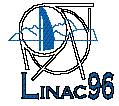Beam Test Results of the INS RFQ/IH Linac
S. Arai, Y. Arakaki, Y. Hashimoto, A. Imanishi, T. Katayama, H. Masuda, K. Niki, M. Okada, Y. Takeda, E. Tojyo, N. Tokuda, M. Tomizawa, K. Yoshida, and M. Yoshizawa
Institute for Nuclear Study, University of Tokyo, Japan
Abstract
As an R&D for the exotic nuclei arena of the Japanese Hadron Project (JHP), a heavy ion linac complex for radioactive beams has been constructed at INS. The linac complex comprises a 25.5-MHz split coaxial RFQ (SCRFQ) and a 51-MHz interdigital-H (IH) linac. The SCRFQ with modulated vanes, 0.9 m in inner diameter and 8.6 m in length, accelerates ions with a charge-to-mass ratio (q/A) greater than 1/30 from 2 to 172 keV/u. The beam from the SCRFQ is charge-stripped by a carbon-foil, and is transported to the IH linac through two magnetic-quadrupole doublets and a 25.5-MHz rebuncher cavity. The IH linac, 5.54 m in total length, comprises four cavities and three magnetic quadrupole triplets placed between cavities. The inner diameter of the cavity is 1.49 m at the first through third ones and 1.34 m at the fourth one. The IH linac accelerates ions with a q/A greater than 1/10, and the output energy is variable in the range of 0.17 through 1.05 MeV/u. Beam tests of the SCRFQ performed with nitrogen ions show that the transmission efficiency exceeds 90% at a design voltage, and the emittance profiles of the output beam agree well with PARMTEQ predictions. After high power tests of the IH linac, acceleration tests of the linac complex will start by using nitrogen ions in early spring of 1996.
Announcements |
Committees |
Exhibition |
General |
Hotels |
Index |
Linacs |
Social |
Welcome |
sln 14 March 1996
 Conference
Conference Conference
Conference